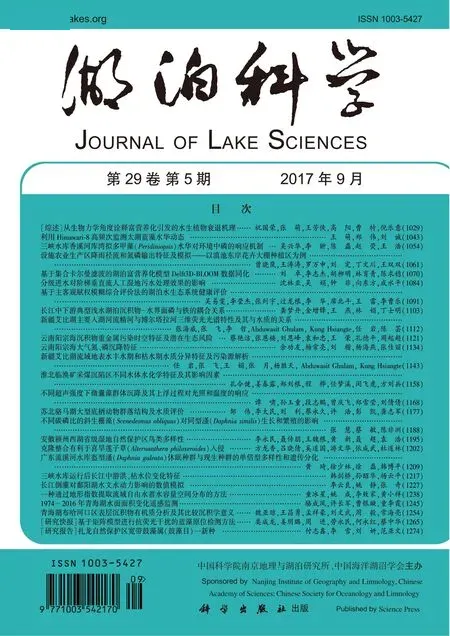扎龙自然保护区宽带鼓藻属(鼓藻目)一新种
付志鑫,李 雪,刘 妍,范亚文
(1:哈尔滨师范大学生命科学与技术学院,哈尔滨 150025)(2:茅台学院,遵义 564500)
扎龙自然保护区宽带鼓藻属(鼓藻目)一新种
付志鑫1,李 雪2,刘 妍1,范亚文1
(1:哈尔滨师范大学生命科学与技术学院,哈尔滨 150025)(2:茅台学院,遵义 564500)
2011-2012年间对扎龙国家级自然保护区的藻类标本进行采集及观察鉴定. 研究发现,该区域鼓藻类植物生物多样性较高,共观察到90个分类单位. 研究过程中发现宽带鼓藻属的一个新种——PleurotaeniumparvulumLi, Fan & Wei. 该物种特征为植物体单细胞,细胞小型,长圆柱形;半细胞顶端平截,其缘边横断面可见5个小结节;细胞壁平滑或具点纹;半细胞具两个轴生星状的色素体,每个色素体具1个蛋白核. 本文比较了该物种与其相近种类之间的差异.
鼓藻;宽带鼓藻属;新种;扎龙国家级自然保护区
藻类作为重要的初级生产者和化学调节剂,是水生生态系统的重要组成成分,为水生生态系统中的其他生物提供了良好的生存环境. 鼓藻是一类淡水藻类. 他们对水质有敏感的指示作用,并且在净化水环境方面起着重要的作用[1]. 一般情况下,鼓藻目经常存在于低电导率和低钙含量的贫营养水体中,例如湖泊、池塘和溪流中. 在沼泽以及沼泽中的水坑里也较为丰富[2-3]. 某些鼓藻即便是出现的个体数量较少,也可以指示出该水体为弱酸和贫营养条件,例如Staurodesmuscrassus(West & G. S. West) S. Lillieroth、尖头叉星鼓藻(S.cuspidatus(Brébisson) Teiling)、S.sellatus(Teiling) Teiling、S.extensusvar.joshuae(Gutwinski) Teiling、S.triangularisvar.limneticusTeiling和长臂角星鼓藻(Staurastrumlongipes(Nordstedt) Teiling)[4-6]. 新月藻属(ClosteriumNitzsch)、鼓藻属(CosmariumRalfs)、角星鼓藻属(StaurastrumRalfs)则通常出现在富营养湖泊中,它们对水体的富营养状况具有指示作用[4]. 例如针状新月藻(ClosteriumaciculareT. West)稀少地分布于发生蓝藻水华的富营养湖泊中(pH为6.7~8.5).
藻类细胞的形态多样性是显而易见的,故鉴定鼓藻几乎完全依据其表面形态. 尽管在过去的20年里,分子生物学的发展越来越迅速,但是当鉴定到属和种的时候,还是要依赖于分类学的方法[7-11],保留传统的形态学鉴别方法是非常必要和实用的[12-14].
宽带鼓藻属是鼓藻科中种类相对较少的一个属. 不同于角星鼓藻属(超过3000个分类单位),宽带鼓藻属目前仅报道有202个分类单位[15]. 宽带鼓藻属通常为单细胞(少数为单列细胞的丝状体),长圆柱形,中部略缢缩. 半细胞顶端平截或具圆形或圆锥形的小结节. 色素体周生,呈许多不规则纵长带状[1],少数种类色素体轴生,长带状.
扎龙国家级自然保护区位于黑龙江省齐齐哈尔市,处在候鸟迁徙的主要路线上,是鹳、鹭、天鹅、水鸟和其他鸟类栖息繁衍的乐园;该地区同时也是丹顶鹤保护区,其内湖泽密布,苇草丛生,是动植物理想的栖息地,具有较高的生物多样性[16].
保护这一地区的水质,一直被视为水生态及相关研究的关键任务. 藻类作为反映水质好坏的一个重要指标,在这一地区的调查依然较少. 本文报道了扎龙国家自然保护区内宽带鼓藻属的一个新种,并对其进行描述.
1 研究区域
扎龙国家级自然保护区位于黑龙江省西部的松嫩平原,由乌裕尔河下游流域一大片芦苇湿地组成(图1). 2011和2012年的春、夏、秋季分别对该区域内的扎龙湖进行藻类标本的采集,共设置了9个采样点,在5个采样点(SV~SIX)和12个采集样品中发现该新种,采集时间、采样点位置以及环境参数等详细信息见表1.

图1 扎龙国家级自然保护区采样点分布Fig.1 Distribution of sampling sites in Zhalong National Nature Reserve

采样点编号样品编号生境地点温度/℃pH电导率/(μS/cm)SV20111026附生扎龙湖南部8.88.2126120120714附生扎龙湖南部30.18.0029820120715浮游扎龙湖南部30.18.0029820120912浮游扎龙湖南部22.68.68274SVI20120709附生扎龙湖北部29.98.8829020120713浮游扎龙湖北部29.98.88290SVII20120718浮游扎龙湖西部29.29.62264SVIII20110720浮游扎龙湖中央21.56.7830220120707浮游扎龙湖中央29.310.27319SIX20110722浮游扎龙湖东部20.66.8830720120701附生扎龙湖东部29.39.5127320120910附生扎龙湖东部22.19.03290
2 材料与方法
浮游样品用25#浮游生物网在水体表面以下 0.5 m处做“∞”字形往复捞取;固着样品的采集主要使用镊子、牙刷等工具刮取附着在水草、石头等基质上的附着物. 采集样品需要用甲醛固定液进行固定(甲醛∶甘油∶蒸馏水=4%∶10%∶86%). 利用光学显微镜(Olympus BH 2)对藻种进行鉴定和拍照;拍摄的图片采用图像处理软件Photoshop 7.0处理. 藻类标本保存在哈尔滨师范大学藻类标本室. 描述术语遵循文献[17-18].
3 结果与讨论
小型宽带鼓藻
PleurotaeniumparvulumLi, Fan & Wei sp. nov. (图2)

图2 小型宽带鼓藻(1:手绘草图;2~12:不同形态的藻类细胞;13~14:生殖状态下的藻类细胞)Fig.2 Pleurotaenium parvulum Li, Fan & Wei sp. nov.
模式标本:图2(1),标本号20120701,保存于哈尔滨师范大学藻类标本室.
副模式标本:标本号20120701-2,保存于中国科学院水生生物研究所.
标本采集地:黑龙江省扎龙国家级自然保护区,刘妍、李雪采集于2011、2012年.
命名依据:依据物种的外形较小将其种名定为parvulum.
描述:植物体为单细胞,细胞小型,长圆柱形,长为宽的6.0~8.6倍,细胞中部略收缢;从半细胞的基部到顶部两侧近平行或从基部到顶部逐渐狭窄,半细胞顶端平截,其缘边横断面可见5个小结节;细胞壁平滑或具点纹;半细胞具两个轴生星状的色素体,每个色素体具1个蛋白核. 细胞长71.0~96.7 μm,基部宽10.6~12.6 μm,缢部宽9.2~11.4 μm,顶部宽7.2~10.8 μm.
分布:扎龙湖5个采样点中的夏季和秋季样品中均能观察到此新种. 湖水pH为7.50~8.45,温度为15.7~26.5℃,电导率为248~337 μS/cm. 优势种为固氮鱼腥藻(AnabaenaazoticaLey)、旋转囊裸藻(Trachelomonasvolvocina(Ehrenberg) Ehrenberg)、极小桥弯藻(CymbellaperpusillaCleve-Euler)和湖生卵囊藻(OocystislacustrisChodat).
Haplotaeniumminutum(Ralfs) Bando(之前被命名为Pleurotaeniumminutum(Ralfs) Hilse)与我们观察到的新种最为相似,这两个物种之间最主要的区别是H.minutum(Ralfs) Bando的半细胞顶端无小结节.Haplotaenium同Pleurotaenium的主要区别在于色素体的形态[19].Haplotaenium的色素体轴生,长带状,每个半细胞只有一个色素体;而Pleurotaenium的色素体为周生或轴生,长带状,每个半细胞有几个色素体[1]. 尽管Pleurotaeniumminutum(Ralfs) Hilse这个名字现在仍在使用[20-22],但是通过基因分析也表明Haplotaeniumminutum(Ralfs) Bando不属于宽带鼓藻属,分子学层面上的研究支持了这个观点[9].
因此,基于色素体的特点,认为该新种在分类学上属于宽带鼓藻属. 其与Haplotaeniumminutum(Ralfs) Bando的区别是:新种较小,半细胞具2个色素体,色素体具1个蛋白核,半细胞顶端平截,且平截面有5个小结节.
Holotype: Fig.2;Sampling No. 20120701, housed at Algae Herbarium, Harbin Normal University.
Isotype: Sampling No. 20120701-2, housed at Institute of Hydrobiology, Chinese Academy of Sciences.
Type Locality: Zhalong National Nature Reserve in Heilongjiang Province, China. By Liu Y & Li X at 2011 and 2012.
Etymology: The epithetparvulumis based on the outline of this species.
Description: The species is a unicellular plant. Cells are small and long cylindrical. Length is 6.0-8.6 times longer than the breadth without processes. Constriction is median to slight. Two sides of the semicell are nearly parallel from the base of the semicell, or converge gradually to the apex. Apices is truncate and provided with small nodules (5 visible in face view). Cell walls are smooth or with puncta. Chromatoplasts, two per semicell, shaped as axial longitudinal ridge. Each chromatoplasts has one pyrenoid. Cell length is 71.0-96.7 μm; basal breadth is 10.6-12.6 μm. Isthmus is 9.2-11.4 μm long, apex breadth is 7.2-10.8 μm.
Distribution: This species occurred in summer and autumn, and was observed from 5 sites in Zhalong Lake. Water pH was from 7.5 to 8.45; water temperature was during 15.7-26.5℃, conductivity was from 248 to 337 μS/cm. The dominant species wereAnabaenaazoticaLey,Trachelomonasvolvocina(Ehrenberg) Ehrenberg,CymbellaperpusillaCleve-Euler, andOocystislacustrisChodat.
The most similar taxon with the new species isHaplotaeniumminutum(Ralfs) Bando, which was named previously asPleurotaeniumminutum(Ralfs) Hilse. The most important difference between these two species is theH.minutum(Ralfs) Bando lack the small nodules at the end of the semicell. Bando (1988) separatedHaplotaeniumfromPleurotaeniumbased on the character of chloroplast[19]. The chloroplasts ofHaplotaeniumare axial and ribbon-like, only one chloroplast per semicell, while those ofPleurotaeniumare parietal and ribbon-like, several chloroplasts per semicell[1]. Although the namePleurotaeniumminutum(Ralfs) Hilse was still used[20-22], molecular analysis showed thatHaplotaeniumminutum(Ralfs) Bando does not group withPleurotaeniumspp. as shown in gene, supporting the separation of these two genera[9].
Therefore, based on the features of chloroplasts, we believe the taxon of the new species belongs to the genusPleurotaenium. Differences fromHaplotaeniumminutum(Ralfs) Bando are obvious: the new species is smaller, two chromatoplasts per semicell, one pyrenoid per chromatoplast, and each semicell has five small nodules transversely.
[1] Gerrath JF. Conjugating green aglae and desmids. In: Wehr JD, Sheath RG eds. Freshwater algae of north America, ecology and classification. San Diego, CA: Academic Press, 2003: 353-379.
[2] Howell ET, South GR. Population dynamics ofTetmemorus(Chlorophyta, Desmidiaceae) in relation to a minerotrophic gradient on a Newfoundland fen.EuropeanJournalofPhycology, 1981, 16(3): 297-312.
[3] Yung YK, Stokes P, Gorham E. Algae of selected continental and maritime bogs in North America.CanadianJournalofBotany, 1986, 64(8): 1825-1833.
[4] Coesel PFM. The significance of desmids as indicators of the trophic status of freshwaters.AquaticSciences, 1983, 45(2): 388-393.
[5] Rosén G. Phytoplankton indicators and their relations to certain chemical and physical factors.Limnologica, 1981, 13(2): 263-290.
[6] Willén E. Planktonic green algae in an acidification gradient of nutrient-poor lakes.ArchivfürProtistenkunde, 1992, 141(1/2): 47-64.
[7] Neustupa J,kaloud P. Geometric morphometrics and qualitative patterns in the morphological variation of five species ofMicrasterias(Zygnemophyceae, Viridiplantae).Preslia, 2007, 79(4): 401-417.
[8] Gontcharov AA, Melkonian M. In search of monophyletic taxa in the family Desmidiaceae (Zygnematophyceae, Viridiplantae): the genusCosmarium.AmericanJournalofBotany, 2008, 95(9): 1079-1095.
[9] Hall JD, Karol KG, McCourt RMetal. Phylogeny of the conjugating green algae based on chloroplast and mitochondrial nucleotide sequence data1.JournalofPhycology, 2008, 44(2): 467-477.
[10] Andrey A, Gontcharov AA, Melkonian M. Molecular phylogeny ofStaurastrumMeyen ex Ralfs and related genera (Zygnematophyceae, Streptophyta) based on coding and noncoding rDNA sequence comparisons.JournalofPhycology, 2005, 41(4): 887-899.
[11] Andreya G, Melkonian M. Molecular phylogeny and revision of the genusNetrium(Zygnematophyceae, Streptophyta):Nucleotaeniumgen. Nov.JournalofPhycology, 2010, 46(2): 346-362.
[12] Flint EA, Williamson DB. Desmids (Chlorophyta), including two new species and three new varieties, in two swamps, a lake, and a tarn in the south island of New Zealand.NewZealandJournalofBotany, 2005, 43(1): 285-300.
[15] Guiry MD, Guiry GM. Algae base. National University of Ireland, Galway: World-Wide Electronic Publication, 2015. http:∥www.algaebase.org; Accessed on 15 November 2015.
[16] https:∥en. wikipedia. org/w/index. php?title=Zhalong_Nature_Reserve & oldid=635149242.
[17] Wei Yinxin ed. Flora Algarum Sinicarum Aquae Dulcis (Tomus VII: Chlorophyta, Zygnematales, Mesotaeniaceae, Desmidiales, Desmidlaceae, Sectio I). Beijing: Science Press, 2003: 1-200. [魏印心. 中国淡水藻志(第七卷:绿藻门·双星藻目·中带鼓藻科·鼓藻目·鼓藻科·第1册). 北京: 科学出版社, 2003: 1-200.]
[18] Wei YX, Yu MJ. Newdesmids material from Donghu Lake, Wuhan, China.ChineseJournalofOceanologyandLimnology, 2005, 23(2): 210-217.
[19] Bando T.Haplotaenium, a new genus separated fromPleurotaenium(Desmidiaceae, Chlorophyta).JournalofJapaneseBotany, 1988, 63: 169-178.
[20] Watanabe MM, Mayama S, Hiroki Metal. Biomass, species composition and diversity of epipelic algae in mire pools.Hydrobiologia, 2000, 421(1): 91-102.
[21] Flint EA, Williamson DB. Desmids (Chlorophyta) in a small tarn in central Canterbury, New Zealand.NewZealandJournalofBotany, 1999, 37(3): 541-551.
[22] Islam AN, Akter N. Desmids of some selected areas of Bangladesh. 3.Docidium,Pleurotaenium,TriplastrumandTriploceras.BangladeshJournalofPlantTaxonomy, 2005, 12(1): 11-23.
A new species ofPleurotaeniumNägeli (Desmidiales) in Zhalong National Nature Reserve, NE China
FU Zhixin1, LI Xue2, LIU Yan1& FAN Yawen1**
(1:CollegeofLifeScienceandTechnology,HarbinNormalUniversity,Harbin150025,P.R.China)(2:MoutaiCollege,Zunyi564500,P.R.China)
A very abundant desmids biota was found in Zhalong National Nature Reserve in 2011-2012, including 90 taxa in total. Among them, aPleurotaeniumspecies is proposed as new to science,PleurotaeniumparvulumLi, Fan & Wei. The new species is characterized of small cells and a long cylinder without processes, a truncated apex, five small nodules on cross section, cell wall smooth or with puncta, semicells with two axial longitudinal ridge-shaped chromatoplasts, and each with two pyrenoids. Differences between the species and allied taxa are discussed.
Desmids;Pleurotaenium; new species; Zhalong National Nature Reserve
国家自然科学基金项目(31270250, 31470308)资助. 2017-02-10收稿;2017-05-07收修改稿. 付志鑫(1991~),女,硕士; E-mail: fuzhixin1991@163.com.
; E-mail: fanyaw@163.com.
DOI 10.18307/2017.0526

